



Table of Contents
- Introduction
- Choosing the Right Dining Table
- Chairs and Seating Arrangements
- Color Schemes and Themes
- Lighting Solutions
- Flooring Options
- Wall Decor and Art
- Incorporating Indian Elements
- Space-Saving Ideas for Small Dining Rooms
- Dining Room Accessories and Textiles
- Creating a Multi-Functional Dining Space
- Greenery and Indoor Plants
- Budget-Friendly Decor Tips
- Dining Room Layout and Furniture Placement
- Enhancing the Dining Experience with Music and Scents
- Seasonal Decor Ideas
- Sustainable and Eco-Friendly Decor
- Conclusion
- Faq's
Creating a beautiful and functional dining room in your home involves balancing aesthetics, comfort, and practicality. Whether you have a spacious dining area or a compact dining nook, these decor ideas will help you transform your space into an inviting haven for family gatherings and entertaining guests.
Introduction
The dining room is more than just a place to eat; it is a space where memories are made and stories are shared. As the setting for family gatherings, celebrations, and everyday meals, the dining room plays a crucial role in fostering connection and communication. A well-designed dining area not only enhances the dining experience but also reflects the personality and style of the household.
In Indian homes, the dining area often serves as the heart of the household, reflecting the family's taste and hospitality. It is a place where traditional values meet modern aesthetics, creating a warm and inviting environment. This article explores various dining room decor ideas tailored to Indian homes, helping you create a welcoming atmosphere for family and friends while enhancing the overall dining experience.
Also Read: Coffee Table Ideas for Small and Big Living Rooms
Choosing the Right Dining Table
The dining table is the centerpiece of your dining room and should be selected with care. It sets the tone for the entire space, influencing both the functionality and aesthetic of the room. Here are some key factors to consider when choosing the perfect dining table:
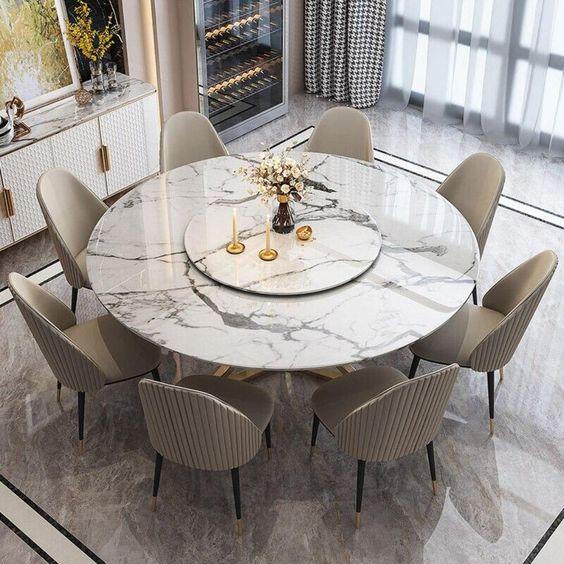 Round Dining Table, Pinterest
Round Dining Table, Pinterest
Size and Shape: The size and shape of your dining table are crucial for ensuring that it fits comfortably within your dining area while allowing enough space for movement. For smaller dining rooms, a round table can be an excellent choice as it maximizes space and facilitates conversation by allowing everyone to see each other. Rectangular tables are ideal for larger spaces, providing ample seating capacity and a classic look. Square tables offer a modern alternative, suitable for square-shaped dining areas, and can often be extended with leaves to accommodate more guests when needed.
Material: The material of your dining table not only affects its appearance but also its durability and maintenance requirements. Wooden tables, whether crafted from oak, walnut, or teak, bring warmth and a timeless appeal to your dining room, and can range from rustic to polished finishes. Glass tables create a sense of openness and modernity, making them perfect for smaller spaces where you want to maintain an airy feel. Metal tables, often featuring sleek designs, are durable and easy to clean, adding a contemporary edge to your decor. Marble tables exude luxury and elegance, though they require regular maintenance to prevent staining and scratches. Choose a material that complements your decor while considering the practical aspects of everyday use.
Style: The style of your dining table should align with your home's overall aesthetic, creating a harmonious look throughout your living space. Modern minimalist designs focus on clean lines and simplicity, often using materials like glass and metal for a sleek appearance. Traditional carved tables, on the other hand, feature intricate details and craftsmanship, making them perfect for homes that embrace classic or vintage decor. Consider the existing elements in your dining room, such as lighting, wall colors, and accessories, when selecting a table style to ensure a cohesive and balanced design. Additionally, think about the role your dining room plays in your home whether it is a formal dining space for special occasions or a casual area for everyday meals and choose a style that reflects its primary function.
Also Read: Tips to Choose the Right Window Furnishings for Your Home
Chairs and Seating Arrangements
Choosing the right chairs is crucial for achieving both comfort and style in your dining room. Your choice of seating can significantly impact the dining experience and the overall aesthetic of the space. Here are some detailed tips to help you select the perfect seating options:
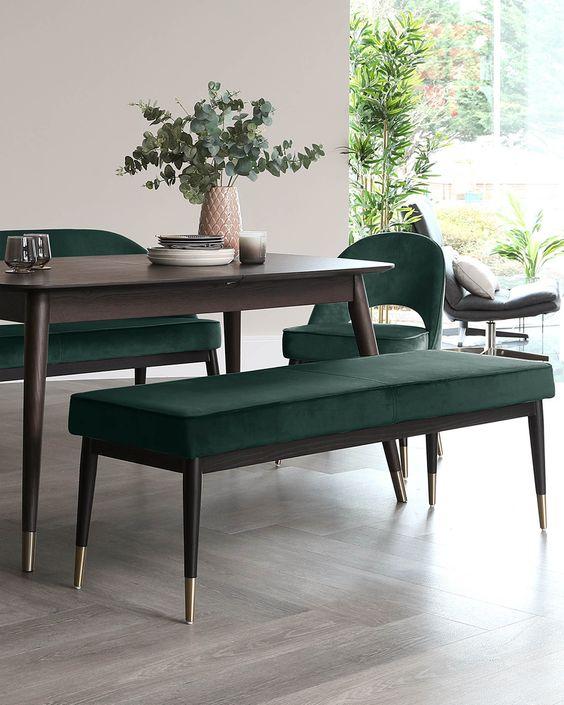 Dining Table Seating, Pinterest
Dining Table Seating, Pinterest
Comfort: Comfort should be a top priority when selecting dining chairs, as guests may spend extended periods sitting during meals and gatherings. Look for chairs with ergonomic designs that provide adequate support for the back and legs. Upholstered chairs are an excellent option for added comfort, offering a soft surface that makes long dinners more enjoyable. Consider the height and cushioning of the chairs to ensure they are compatible with your dining table and provide a comfortable dining posture. Additionally, chairs with armrests can enhance comfort, particularly for older family members or guests who appreciate extra support.
Mix and Match: For those who enjoy a dynamic and personalized look, mixing different chair designs can create an eclectic and visually interesting dining area. This approach allows you to combine various materials, colors, and styles, resulting in a unique and curated appearance. For example, you could pair wooden chairs with metal ones or introduce chairs with different upholstery patterns for a vibrant and lively feel. When mixing and matching, it's important to maintain some cohesive elements, such as a common color palette or complementary styles, to avoid a disjointed look. Alternatively, for a more uniform appearance, choose matching sets of chairs that align with the overall theme of your dining room.
Bench Seating: Benches offer a practical and stylish alternative to traditional chairs, particularly in homes with limited space or a desire for a casual, communal atmosphere. Benches can be positioned along one side of the dining table or tucked beneath it when not in use, maximizing space efficiency. They are ideal for families with children, as they can accommodate more people and allow for easy movement during meals. Additionally, benches can be paired with cushions or throws to enhance comfort and add a touch of color and texture to the dining area. Consider using benches with storage compartments to keep dining essentials or extra linens handy, further optimizing the functionality of your space.
Also Read: Vaulted Ceilings: A Guide to Stylish Home Interiors
Color Schemes and Themes
Color plays a significant role in setting the mood and ambiance of your dining room. It can influence the perception of space, enhance your decor style, and reflect your personal taste. Here are some ideas to consider when choosing the color scheme and theme for your dining room:
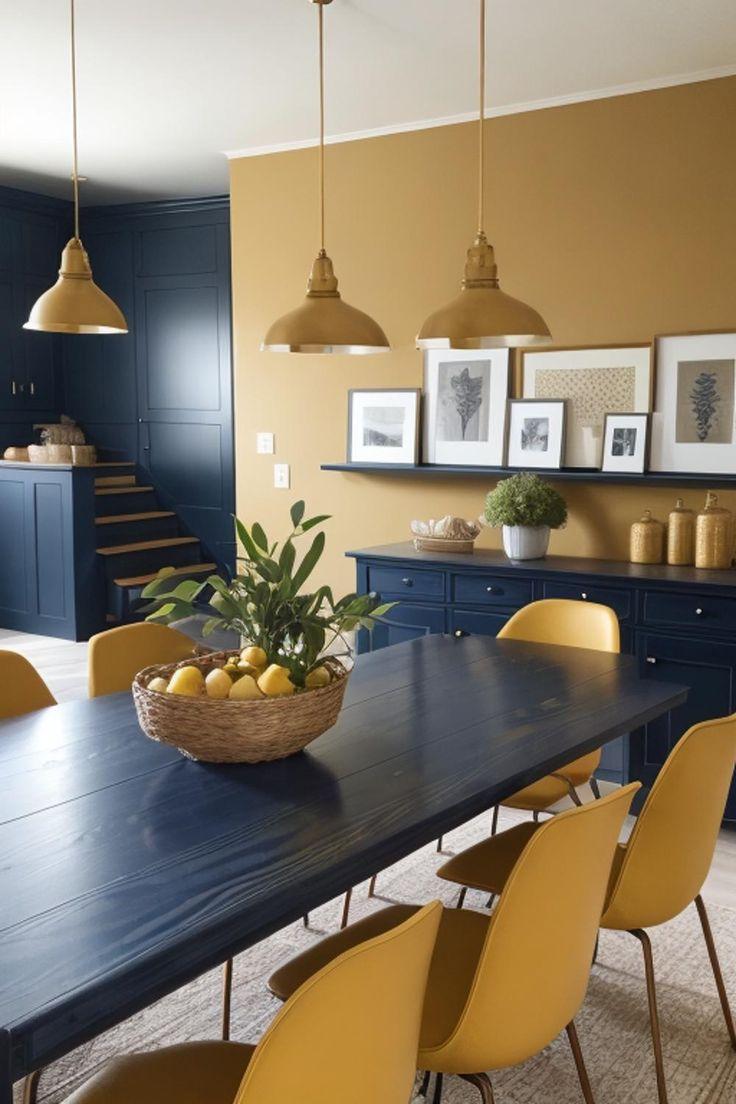 Dining Area Color Scheme, Pinterest
Dining Area Color Scheme, Pinterest
Neutral Tones: Neutral colors like whites, beiges, and greys are timeless choices that create a calm and sophisticated atmosphere. These hues provide a versatile backdrop that can complement a variety of furniture styles and accessories. White walls can make a space feel airy and open, while beige tones add warmth without overwhelming the senses. Grey offers a modern and sleek look, working well with contemporary and minimalist decor. To add depth and interest to a neutral color scheme, incorporate different textures and materials, such as wooden furniture, metallic accents, and soft textiles. This approach ensures that the space remains visually engaging while maintaining its serene and elegant vibe.
Bold Colors: Incorporating bold colors like deep blues, rich greens, or vibrant yellows can add personality and warmth to your dining room. These colors can create a striking focal point and infuse the space with energy and vibrancy. Deep blues, reminiscent of the ocean or night sky, can evoke a sense of tranquility and sophistication, especially when paired with white or metallic accents. Rich greens bring a touch of nature indoors, creating a fresh and invigorating environment. Vibrant yellows can add a cheerful and welcoming feel, ideal for spaces that benefit from a pop of color. When using bold colors, consider accent walls, colorful furniture pieces, or accessories to balance the overall look and prevent the space from feeling overwhelming.
Indian Themes: Embrace the richness of Indian culture by incorporating traditional colors like maroon, gold, and saffron into your dining room decor. These colors are deeply rooted in Indian heritage and can bring warmth and a sense of tradition to your space. Maroon, a deep and luxurious shade of red, adds depth and elegance, especially when used in upholstery or drapery. Gold accents, whether in the form of decorative elements, lighting fixtures, or tableware, can add a touch of opulence and sophistication. Saffron, with its warm and earthy tone, can be used as an accent color to evoke a sense of vibrancy and positivity. To create a cohesive Indian-themed dining room, consider incorporating traditional patterns, textiles, and artwork that celebrate the country's diverse cultural heritage.
Also Read: Quartz Kitchen Countertops for Home: A Comprehensive Guide
Lighting Solutions
Lighting can transform the ambiance of your dining room, influencing both the mood and functionality of the space. The right lighting not only highlights your decor but also enhances the dining experience. Here are some lighting options to consider:
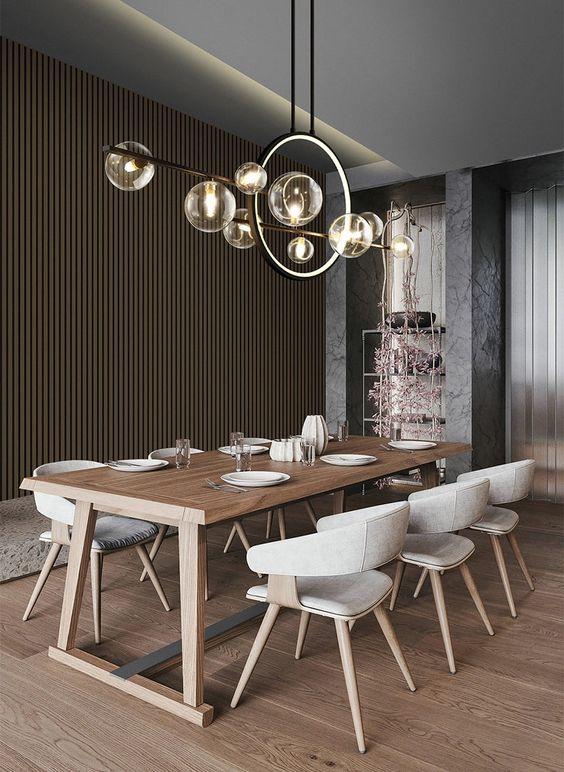 Lighting Solutions, Pinterest
Lighting Solutions, Pinterest
Chandeliers: A chandelier can be a stunning focal point that elevates the elegance of your dining room. When choosing a chandelier, consider the size and style of your dining table and room. For a cohesive look, select a chandelier that complements the shape and scale of your table. For instance, a linear chandelier works well over a rectangular table, while a round chandelier suits circular tables. Chandeliers with dimmable features allow you to adjust the lighting intensity, creating the perfect ambiance for different occasions.
Pendant Lights: Pendant lights are an excellent choice for modern spaces, offering versatility and visual interest. They can be hung individually or in clusters at varying heights to create a dynamic and contemporary look. Pendant lights come in various designs, from sleek metal finishes to glass or fabric shades, allowing you to tailor the lighting to your decor style. Position pendant lights strategically to provide focused illumination on the dining table while adding a decorative element to the room.
Wall Sconces: Wall sconces provide soft, ambient lighting that enhances the dining room's atmosphere. They can be used to highlight artwork, or architectural features, or simply to create a warm glow along the walls. Wall sconces are ideal for adding layers of light, complementing overhead fixtures, and creating a cozy and inviting environment. Choose designs that coordinate with your overall decor, whether it's a minimalist sconce for a modern space or an ornate one for a traditional setting.
Also Read: Oxide Flooring for Homes: Designs, Benefits & Maintenance Tips
Flooring Options
The right flooring can enhance your dining room's look and feel, contributing to the overall aesthetic and functionality. Consider these flooring options:
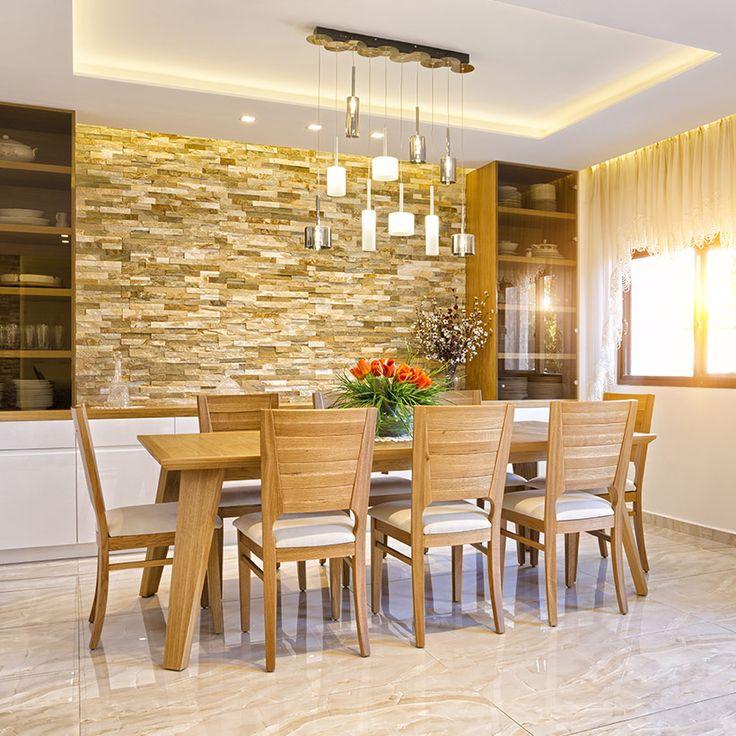 Dining Room Flooring, Pinterest
Dining Room Flooring, Pinterest
Wooden Floors: Wooden floors are a timeless and classic choice that adds warmth and elegance to any dining room. They suit both modern and traditional styles, offering versatility in terms of finishes and shades. From light oak to dark walnut, wooden floors can complement a variety of color schemes and decor themes. Additionally, wooden floors are durable and can be refinished to maintain their appearance over time.
Tiles: Tiles are a practical flooring option for dining areas, offering durability and ease of maintenance. Available in a wide range of colors, patterns, and textures, tiles can mimic the appearance of natural stone, wood, or concrete, providing flexibility in design. Tiles are particularly suitable for households with high foot traffic or those seeking a clean and contemporary look. They are also resistant to spills and stains, making them a practical choice for dining rooms.
Rugs: A well-placed rug can define the dining area, add warmth, and enhance the overall decor. Rugs come in various sizes, materials, and patterns, allowing you to choose one that complements your dining room's color scheme and style. When selecting a rug, ensure it is large enough to accommodate the dining table and chairs, even when the chairs are pulled out. Rugs with low piles or flat weaves are ideal for dining rooms, as they are easier to clean and maintain.
Also Read: 15 Gypsum False Ceilings Ideas For Your Home 2024
Wall Decor and Art
Enhance your dining room walls with art and decor to create a personalized and engaging space:
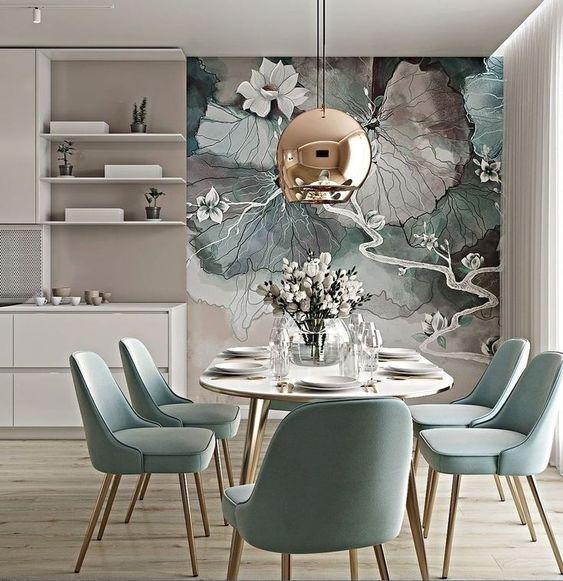 Dining Room Wall Decor, Pinterest
Dining Room Wall Decor, Pinterest
Art Pieces: Hang paintings, prints, or photographs that reflect your taste and style. Art can serve as a conversation starter and add character to your dining room. Consider a large statement piece to anchor the room or a gallery wall of smaller works for a dynamic display. Choose frames and colors that complement your overall decor and create a cohesive look.
Mirrors: Use mirrors to create the illusion of space and add elegance to your dining room. Mirrors can reflect light, making the room appear larger and brighter. Consider placing a mirror opposite a window to maximize natural light or behind a buffet table to enhance the sense of depth. Decorative mirrors with ornate frames can serve as both functional and artistic elements.
Wall Panels: Decorative wall panels can add texture and depth to your dining room walls. Panels made from wood, fabric, or metal can create a focal point and enhance the room's visual interest. Consider using wall panels as a backdrop for the dining table or to highlight a specific area of the room. They can also serve as acoustic elements, reducing noise and enhancing the dining experience.
Also Read: Tufted Furniture for Your Home: A Blend of Style and Comfort
Incorporating Indian Elements
Embrace Indian culture and heritage in your dining room decor to create a warm and inviting atmosphere:
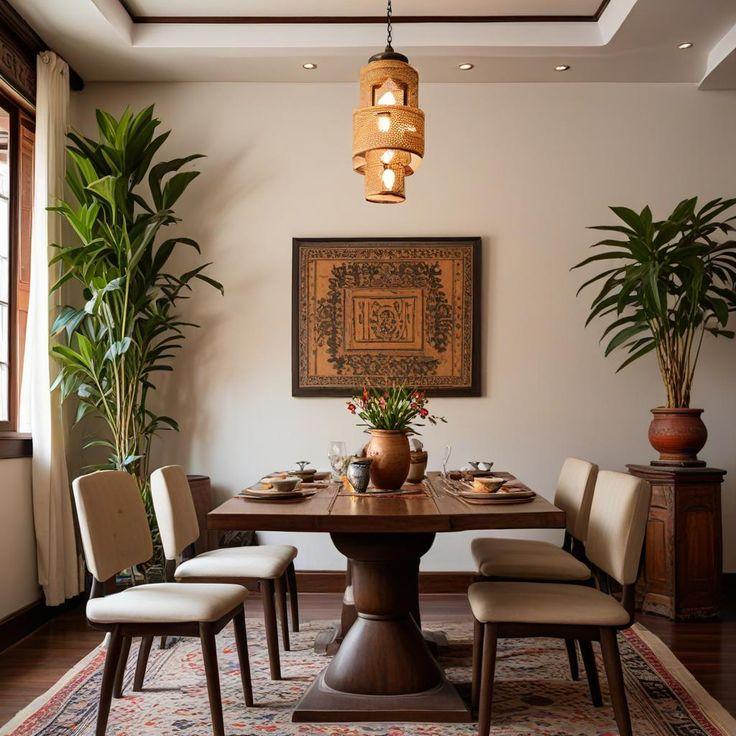 Incorporating Indian Elements in Dining Room, Pinterest
Incorporating Indian Elements in Dining Room, Pinterest
Textiles: Use Indian fabrics like silk or cotton for tablecloths, napkins, and curtains. These textiles often feature intricate patterns and vibrant colors that add richness and warmth to the dining room. Consider using block-printed or embroidered fabrics to highlight traditional Indian craftsmanship.
Artifacts: Display traditional Indian pottery, sculptures, or brassware as centerpieces or decor elements. These artifacts can add cultural significance and a touch of authenticity to your dining room. Consider incorporating items like terracotta pots, carved wooden figures, or metal lamps to create a cohesive and culturally rich decor.
Patterns: Incorporate Indian patterns like paisley, block prints, or ikat in your decor through textiles, wallpaper, or upholstery. These patterns can add visual interest and a sense of history to the space. Consider using patterned cushions, table runners, or wall art to create a layered and harmonious look.
Also Read: 16 Stunning Double Door Design Ideas for Your Home - 2024
Space-Saving Ideas for Small Dining Rooms
Maximize your dining space with these ideas, ensuring functionality and style even in compact areas:
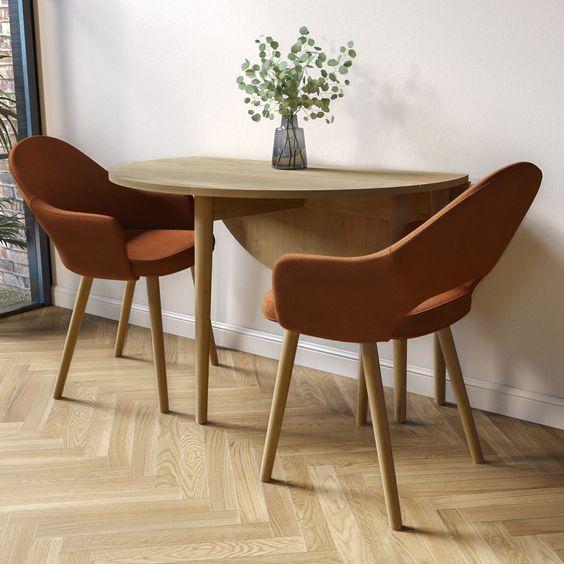 Space Saving Dining Area, Pinterest
Space Saving Dining Area, Pinterest
Foldable Furniture: Use extendable tables or foldable chairs to save space. These pieces can be easily stored or adjusted to accommodate different numbers of guests. Look for tables with built-in extensions or chairs that can be stacked or folded away when not in use.
Wall-Mounted Shelves: Utilize vertical space for storage or display with wall-mounted shelves. These shelves can hold decorative items, dinnerware, or plants, freeing up floor space and adding visual interest. Consider installing shelves at varying heights to create a dynamic and functional display.
Built-In Seating: Consider built-in benches with storage underneath to optimize space and functionality. Built-in seating can be customized to fit your dining area and provide additional storage for table linens, dinnerware, or other essentials. Add cushions and throws to enhance comfort and style.
Also Read: Italian Or Indian Marble: What to Choose?
Dining Room Accessories and Textiles
Accessories and textiles can add personality, charm, and comfort to your dining room, enhancing both its aesthetic and functionality. Here are some ways to incorporate them effectively:
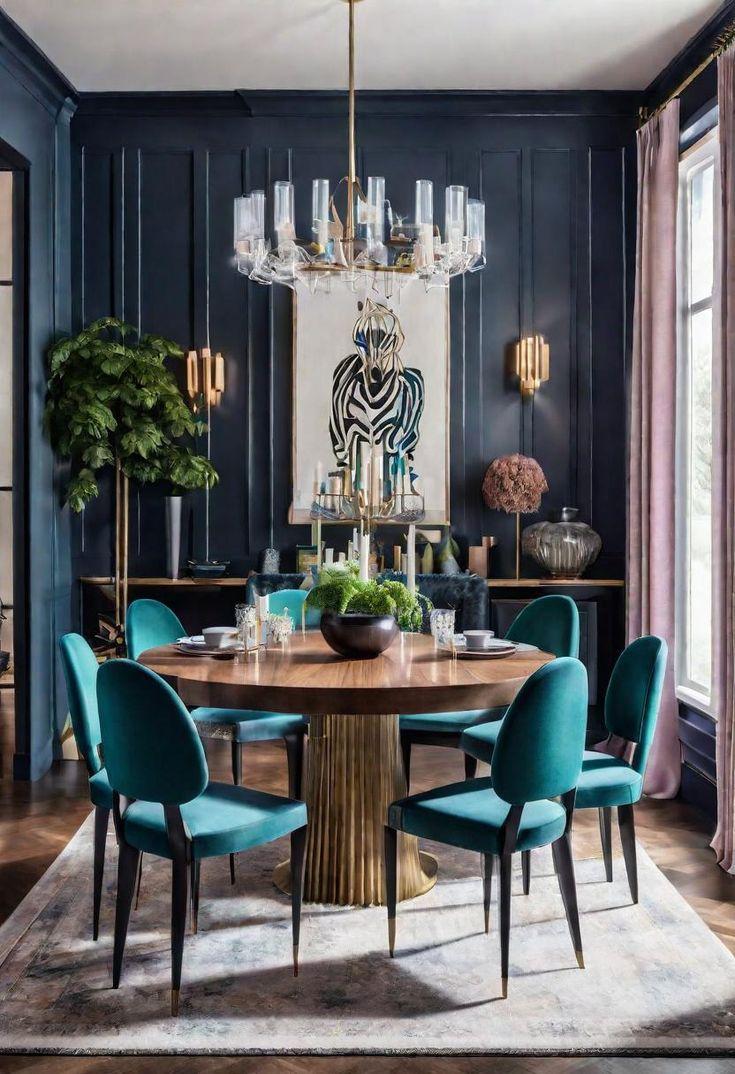 Dining Room Accessories, Pinterest
Dining Room Accessories, Pinterest
Tableware: Investing in quality dinnerware and cutlery is essential for creating an inviting dining experience. Choose tableware that complements your decor style, whether it's modern, rustic, or traditional. Consider materials like porcelain or stoneware for a classic look, or opt for glass and stainless steel for a contemporary touch. Mix and match patterns and colors for a unique and personalized table setting that reflects your style and taste.
Table Runners and Placemats: Use table runners and placemats to add color, texture, and layers to your table setting. They can protect your table from spills and scratches while providing an opportunity to introduce patterns and colors that tie into your overall decor. Choose materials like cotton, linen, or bamboo, and coordinate them with your tableware and napkins for a cohesive look. Table runners can be used to highlight a centerpiece, while placemats define individual dining spaces.
Cushions and Throws: Adding cushions and throws to your dining chairs can enhance comfort and style. Cushions provide additional support and can soften hard seating, while throws add warmth and texture. Select fabrics that complement your color scheme and consider seasonal changes by swapping out cushions and throws for different colors or textures throughout the year. These textiles can also be an excellent way to introduce patterns and designs that reflect cultural influences or personal preferences.
Also Read: 15 Sofa Table Ideas for Your Home: 2024
Creating a Multi-Functional Dining Space
In modern homes, dining rooms often serve multiple purposes beyond just meals. Here are some ideas to make your dining space versatile and functional:
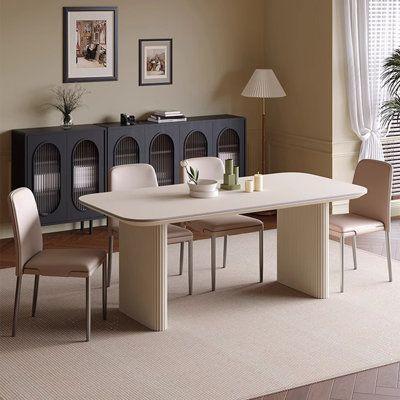 Multi-Functional Dining Room, Pinterest
Multi-Functional Dining Room, Pinterest
Work and Study Area: Use your dining table as a workspace during the day. Ensure you have adequate lighting and consider using portable office supplies or storage to easily transition between dining and working modes. A multi-functional dining space can be especially useful in smaller homes or apartments where space is limited.
Storage Solutions: Incorporate sideboards, cabinets, or shelves to provide additional storage for dining essentials like dishes, glassware, and linens. These storage options can also be used to display decorative items, adding visual interest to the room. Choose furniture with closed storage to keep the space tidy and organized.
Play Area: Create a play corner for children when not dining. Use a small table or rug to define the play area, and incorporate storage bins or baskets for toys and games. This setup allows children to play nearby while adults enjoy meals or work, making the dining room a family-friendly space.
Also Read: Hanging Light Ideas for Your Bedroom
Greenery and Indoor Plants
Adding greenery and indoor plants can bring life and freshness to your dining room, improving air quality and enhancing aesthetics:
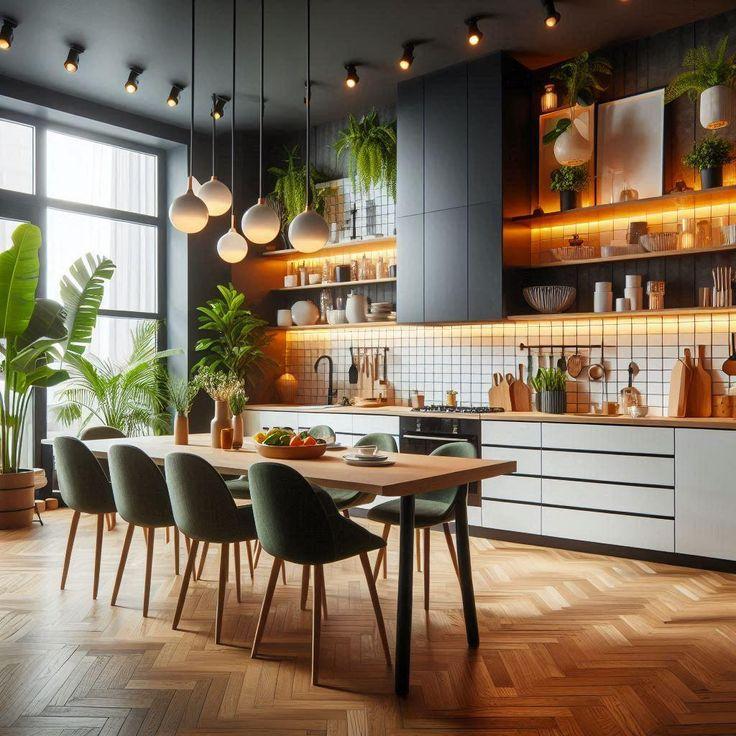 Dining Room Indoor Plants, Pinterest
Dining Room Indoor Plants, Pinterest
Centerpieces: Use potted plants or floral arrangements as table centerpieces to add natural beauty and a touch of elegance. Choose plants or flowers that complement your decor and consider seasonal changes to keep your arrangements fresh and interesting. Low-profile centerpieces are ideal to avoid obstructing views and conversations.
Hanging Plants: Incorporate hanging plants to add greenery without taking up valuable floor or table space. Hanging plants can create a sense of depth and visual interest, especially in rooms with high ceilings. Consider using macrame hangers or decorative pots to enhance the overall decor.
Low-Maintenance Options: Choose low-maintenance plants like succulents, peace lilies, or snake plants for easy care. These plants require minimal watering and can thrive in various lighting conditions, making them perfect for dining rooms. Arrange them on shelves, sideboards, or window sills to create a cohesive and inviting atmosphere.
Also Read: Bookshelf Design Ideas: Creative Ways to Display Your Collection
Budget-Friendly Decor Tips
Decorating your dining room doesn't have to be expensive. Here are some budget-friendly tips to achieve a stylish look without breaking the bank:
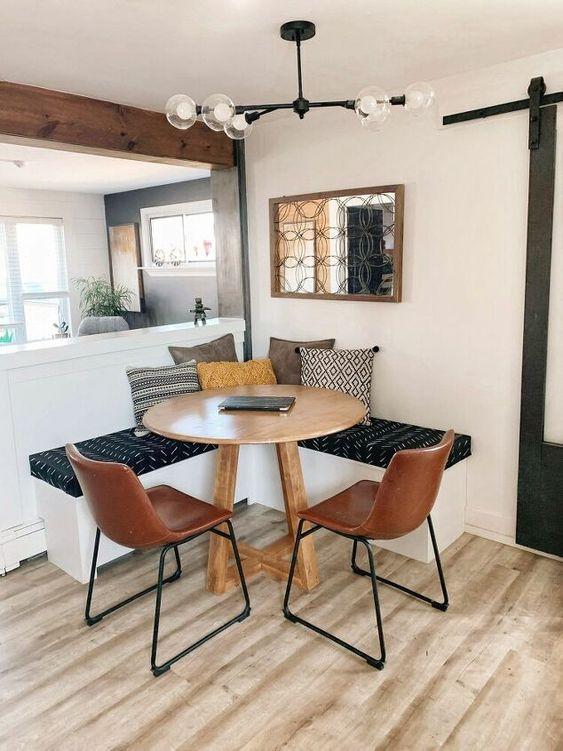 Budget Friendly Dining Room Decor, Pinterest
Budget Friendly Dining Room Decor, Pinterest
DIY Projects: Create your own art or decor pieces to personalize your dining room. This could include painting canvases, crafting centerpieces, or making your table runners and placemats. DIY projects allow you to express your creativity and tailor the decor to your specific tastes and needs.
Upcycle: Refurbish old furniture or accessories for a new look. Sand and repaint chairs or tables, reupholster dining chairs or repurpose items like crates and pallets into functional furniture pieces. Upcycling not only saves money but also reduces waste and adds unique character to your dining room.
Second-Hand Finds: Explore thrift stores, flea markets, or online marketplaces for unique and affordable decor items. Vintage or second-hand pieces can add charm and character to your dining room, often at a fraction of the cost of new items. Look for items that can be easily updated or combined with your existing decor for a cohesive look.
Also Read: Budget-Friendly Home Decor Ideas to Transform Your Space
Dining Room Layout and Furniture Placement
Optimizing your dining room layout is essential for comfort, functionality, and aesthetic appeal. Here are some tips for arranging your space effectively:
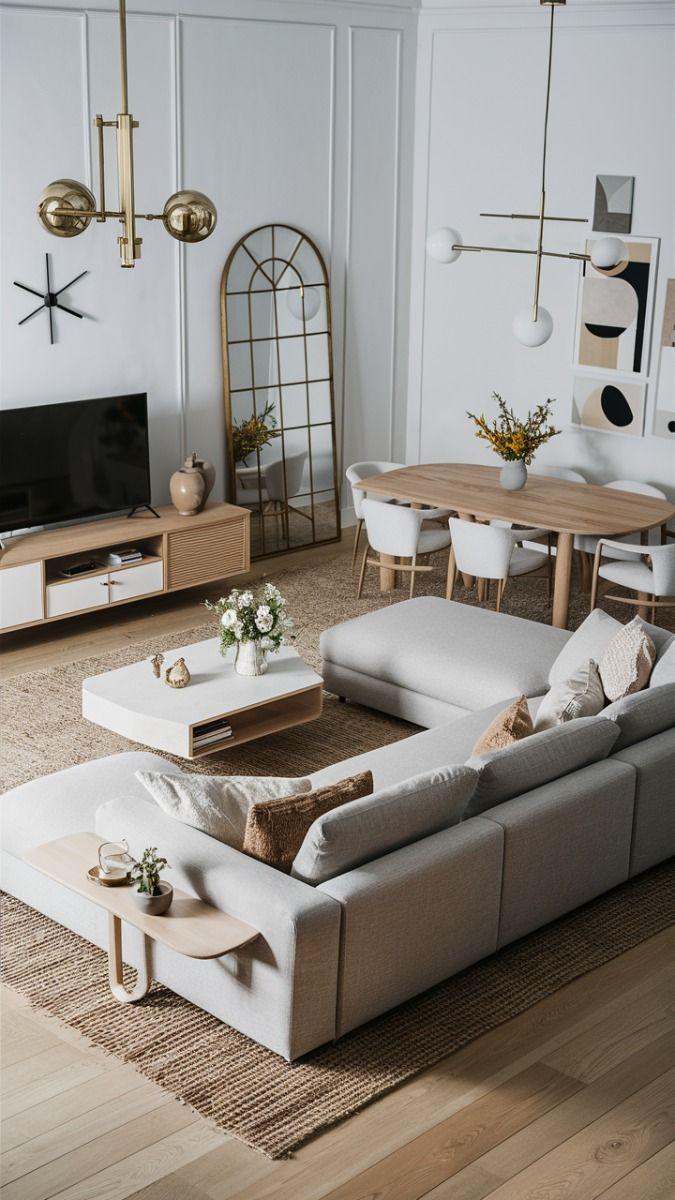
Symmetry: Arrange furniture symmetrically to create a balanced and harmonious look. Symmetry can be achieved by centering the dining table in the room and arranging chairs evenly around it. Balance can also be maintained by placing matching sideboards or cabinets on either side of the table or by using identical lighting fixtures.
Traffic Flow: Ensure there is enough space for movement around the table. Allow at least 36 inches (91 cm) of clearance between the edge of the table and walls or other furniture to facilitate easy access and comfortable seating. Consider the flow of foot traffic in and out of the dining room and position furniture to accommodate natural pathways.
Zoning: Use rugs or furniture placement to define different areas within the dining room. A rug under the dining table can anchor the space and delineate the dining area from adjacent living or kitchen spaces. Similarly, furniture placement, such as sideboards or shelves, can be used to create distinct zones for dining, storage, or display.
Enhancing the Dining Experience with Music and Scents
Creating a sensory dining experience can elevate your meals and enhance the ambiance of your dining room:
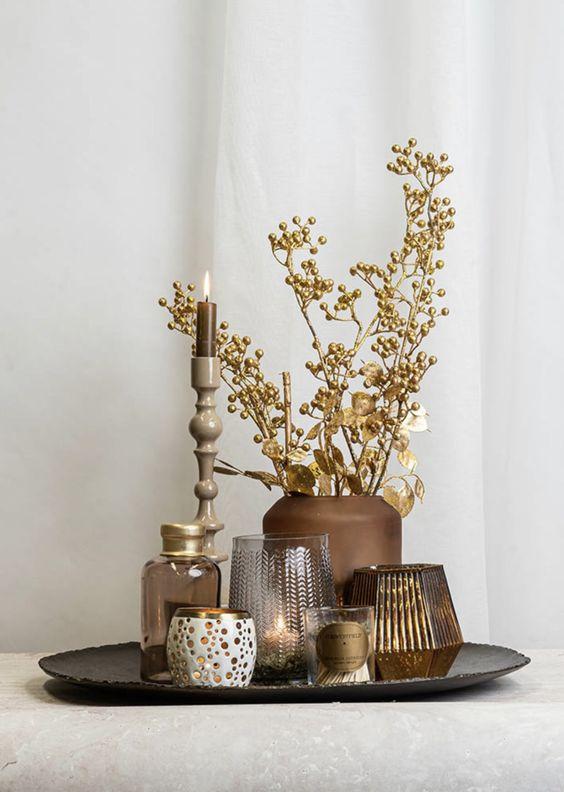 Dining Area Scents, Pinterest
Dining Area Scents, Pinterest
Background Music: Play soft music to enhance the ambiance and create a relaxing atmosphere. Choose instrumental or classical music for a soothing effect or opt for jazz or acoustic tunes for a more lively vibe. Music can help set the tone for different occasions, whether it's a casual dinner with family or a formal gathering with friends.
Aromatherapy: Use scented candles, diffusers, or incense to create a pleasant atmosphere and stimulate the senses. Select scents that complement the dining experience, such as citrus or herbal fragrances for freshness or vanilla and cinnamon for warmth. Be mindful of scent intensity to ensure it enhances rather than overpowers the dining environment.
Also Read: Laminate Flooring: A Versatile and Cost-Effective Solution for Homes
Seasonal Decor Ideas
Updating your dining room decor with the seasons can keep the space fresh and inviting. Here are some seasonal decor ideas:
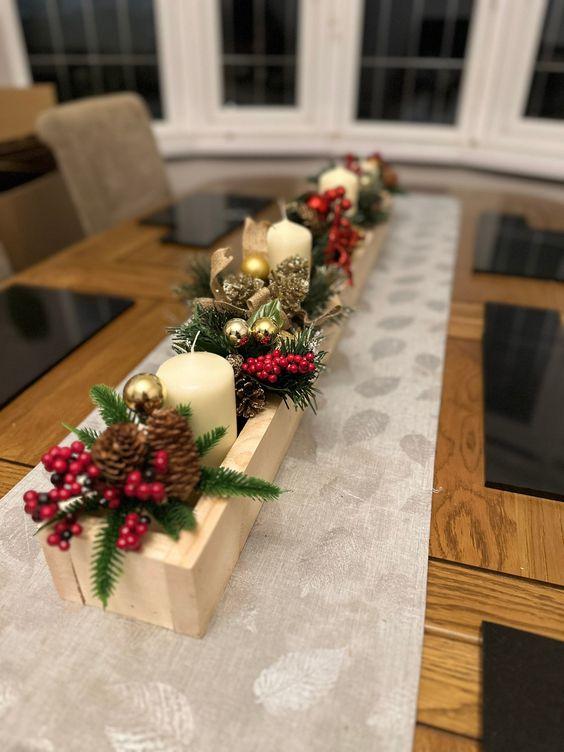 Dining Room Seasonal Decor, Pinterest
Dining Room Seasonal Decor, Pinterest
Festive Decor: Incorporate seasonal colors and decorations for festivals and holidays. For example, use rich reds and golds during Diwali, or introduce green and white for a fresh, springtime feel. Festive decor can include tableware, centerpieces, and wall hangings that reflect the spirit of the season.
Winter Warmth: Use cozy textiles and warm colors to create a snug atmosphere during winter. Introduce soft throws, plush cushions, and heavy drapes in warm hues like burgundy, deep green, or navy blue. Consider using candles or fairy lights to add a touch of warmth and sparkle to your dining room.
Summer Freshness: Opt for light fabrics and fresh flowers in summer to create an airy and vibrant feel. Choose bright and cheerful colors like yellow, turquoise, or coral to reflect the energy of the season. Sheer curtains, floral centerpieces, and lightweight tablecloths can enhance the summary ambiance.
Also Read: Wooden Decor Ideas for Indian Homes: Types, Benefits, Vastu Implications
Sustainable and Eco-Friendly Decor
Adopting eco-friendly practices in your dining room can reduce your environmental impact and promote a sustainable lifestyle:
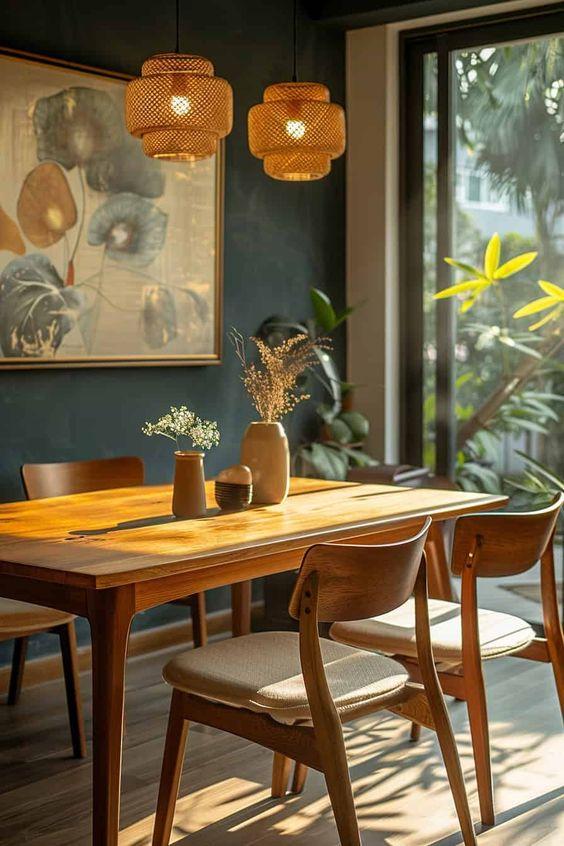 Eco-Friendly Dining Room Decor, Pinterest
Eco-Friendly Dining Room Decor, Pinterest
Recycled Materials: Choose furniture and decor made from recycled materials, such as reclaimed wood, recycled glass, or repurposed metal. These materials can add character and uniqueness to your dining room while supporting sustainable practices.
Sustainable Fabrics: Opt for organic cotton or linen textiles, which are made from natural fibers and produced using environmentally friendly methods. These fabrics are durable, breathable, and biodegradable, making them an excellent choice for tablecloths, napkins, and cushions.
Energy-Efficient Lighting: Use LED lights to reduce energy consumption and promote sustainability. LED lights are long-lasting and consume less power than traditional bulbs, helping to lower your energy bills and carbon footprint. Consider using dimmable LED fixtures to adjust the lighting to suit different moods and occasions.
Also Read: Stunning Ideas for Using Dark Colors in Your Home
Conclusion
Creating a beautiful and functional dining room is about blending style, comfort, and practicality. Whether you're hosting a formal dinner or enjoying a casual meal with family, these dining room decor ideas will help you craft a space that reflects your taste and meets your needs.
explore further
Latest from Contemporary ideas
More from Innovations
Resources
Dwello, for every home buyer, is a way to go from 'I feel' to 'I know', at no extra cost.




